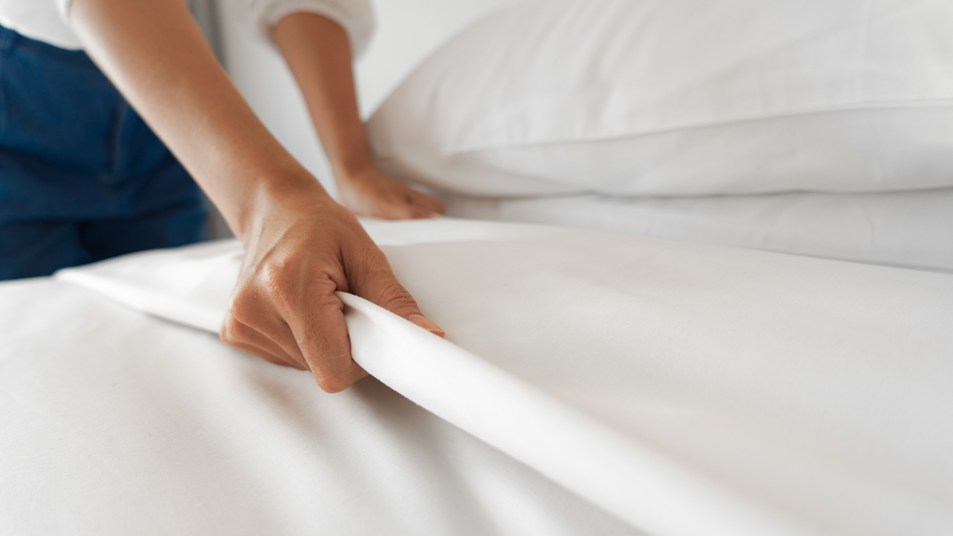3 Ways to Guarantee You’re Buying the Best Quality Bed Linen

Considering we spend a major portion of our lives in bed, choosing quality bed linen is essential to ensuring our beds are the relaxing havens they ought to be.
Bedding essentially serves two purposes: It plays a huge part in your bedroom’s overall look, plus it can create an inviting, comforting cocoon that you look forward to at the end of a long day — and never want to leave when your alarm goes off!
Since it plays such a pivotal role in your bedroom (and arguably your sleep), it’s not a purchase that should be cutting corners on. High-quality, luxury bed linen is an investment that will pay for itself ten-fold. But, given the huge array of choice on offer in terms of fiber, finish, design and, of course, thread count, it can be difficult to narrow down the best option.
To make life easier, and sleep better, we’ve compiled this foolproof buyer’s guide to high-quality bed linen that covers off everything you need to know before shopping for sheets.
Fiber Type
It’s a common misconception that thread count is the only indicator of quality, but fiber actually plays a big part in the caliber of bedding, too. More specifically, the length, fineness, and strength of the fiber used. For the most part, cotton is the go-to fiber for bed linen due to its soft, comfortable and breathable nature. It’s also a super durable fabric that ages well.
In terms of specifics, you should look for a long fiber if you’re after high-quality bed linen. Egyptian cotton is considered the best type of cotton because it has a fine, long fiber. Pima cotton is the next step down with medium-to-long fibers making it a more affordable, but still good quality option. If something’s pitched as 100 percent cotton, it’s typically upland cotton, which is good value, but more likely to pile and feel coarse thanks to its short fiber length.
Linen and bamboo fibers are both known for their insulation benefits, keeping you cool on balmy summer evenings and warm in winter, too. “Bamboo bedding has been increasing in popularity in recent times — and for good reason”, says Ettitude’s founder and CEO Phoebe Yu. “It’s sustainable, softer than cotton and linen, and moisture-wicking. But it’s not all created equal, so be sure to read up on how it’s made.”
If you’re after the ease of a cotton-polyester blend (bonus: no ironing) try to keep the polyester element below 10 percent otherwise you lose the softness and insulation benefits.
Thread Count
Once you’ve sussed out your chosen fiber, you can use thread count to further decipher quality. Put simply, thread count refers to the number of threads woven into one square inch of fabric. The higher the number of threads, the higher the thread count.
As a general guide, good quality bedding will typically have a 200-800 thread count. However, it’s worth noting that a high thread count alone doesn’t truly indicate quality; fabric type should always be factored in, too. For example, a 400 thread count Egyptian cotton sheet will be softer and feel more luxurious than a 600 thread count polyester-blend sheet.
Keep in mind that anything with a thread count over 600 will be denser and heavier, making them more suited to the colder months. And, it pays to be cautious of bedding with a with a thread count over 800 with a price tag that seems too good to be true. It’s likely a marketing ploy using multiple-ply thread or picks to the boost thread count.
Its also worth considering that thread count can mean different things depending on the fabric. Pure linen sheets, for example, do not often boast about their “thread count”, as linen is usually measured in grams per square meter (GSM).
Weave
Different types of weaves have different characteristics and, as such, the type of weave used affects the softness and feel of your bed linen. A standard weave, at the lower end of the scale, features an equal number of vertical and horizontal yarns and often isn’t advertised on the packaging.
Percale is a plain-weave fabric where the fibers are tightly woven to create a fine texture and finish. The result is a crisper, cooler and more luxurious fabric that feels the same on both sides. Typically a percale weave must have a minimum thread count of 180 so it’s a good benchmark for quality bedding.
Sateen weaves are the next step up in terms of softness. Due to the structure of a satin weave, the end result is very smooth, soft and shiny. However the weave is not as durable as the one-under-one-over weave construction that’s used to craft percale bedding.
TThis article originally appeared on our sister site, First For Women.












